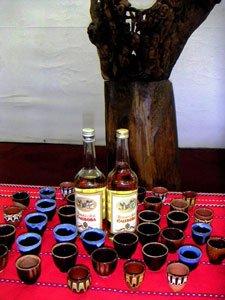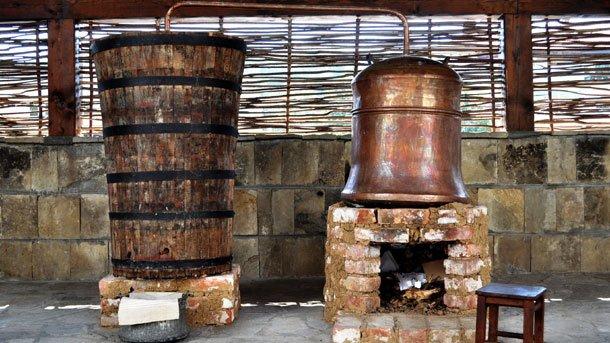
© Photo: Veneta Nikolova
To go to Troyan and not to taste the plum brandy is equal to going Rome and not seeing the Pope, locals laugh. They welcome each guest with a small glass of the drink, one can taste its different versions at restaurants and taverns across the whole town. The appetizers that go with it – salads of fresh vegetables, homemade sheep and goat cheese, bacon, covered with aroma herbs, flat sausages… these goodies tickle the roof of the mouth, turning the tasting of Troyan’s plum brandy into a magnificent and unforgettable experience. The production process obeys to centuries-old traditions that make it a kind of art. The amber drink has its own display in the yard of the local art crafts museum. It tells us that back in 1871 Hungarian traveler Felix Kraniz mentioned in his chronicles the skills of Troyan people, who mastered the homemade brandy with local plum sort with high concentration of sugar and pits that could be easily separated from the fruit. Supposedly, the Troyan Monastery monks were the first to start boiling brandy as early as the 16th century, while the recipe was kept in secret and passed from one abbot to another. However, we know that the monastery drink contained about 40 herbs.

© Photo: Veneta Nikolova
The museum exposition presents their detailed description. We also learn that in 1882 the Troyan plum brandy gained its first world recognition – a diploma and a bronze medal at the exhibition in the Belgium town of Anvers. The qualities of this alcohol elixir have been assessed by emblematic people, such as Pope John Paul II and former US President Bill Clinton. Practically not a single brandy fan can resist the magical impact of the amber drink. This gives an explanation to a curious anecdote from the past, told by Mrs. Eleonora Avdjieva, the museum’s director:
“Back in 1928 a referendum took place in the Troyan village of Lometz, demanding the closure of pubs. Of course, the production of such large quantities of brandy meant lots of consumption. The referendum resulted in 115 votes for the shutting down and only 7 against. However, the results didn’t stand long, because an unexpected side effect occurred. The sworn fans started to tour the neighboring villages and sometimes failed to return for days. Serious scandals occurred and it became clear that traditions couldn't be wiped out by party campaigns.”

© Photo: Veneta Nikolova
Thousands of tourists from this country and abroad visit Troyan each autumn, in order to attend the festival of plum brandy. The program of this alcohol fiesta envisages folklore events, tasting of Troyan delicacies, joking tours and, of course drinking competitions. Once you’ve tasted it, you will want more… What is the secret of the good Troyan brandy? The size of the vessel, where the fermentation takes place is one of the conditions, local experts reveal. The bigger the vessel, the better the quality of the plum brandy. However, the most important thing for a nice tasting is the good mood and nice company in the heart of the Troyan Balkan.
English version: Zhivko Stanchev
As in 2024, this season's vacancies in the tourism industry will be filled by workers from third countries . According to employers from the Northern Black Seacoast, entire Turkish teams are employed in the kitchens of Albena resort. Workers from..
The first tourists of the new tourist season arrive today on a flight from the Polish city of Krakow. At Burgas Airport, they will be welcomed with a water salute and souvenir gifts in the presence of the Minister of Tourism Miroslav Borsos and the..
Intense preparations are underway on the Southern Black Sea coast for the upcoming summer season. The first tourists are expected for Easter, and businesses are actively seeking thousands of workers, reports public service broadcaster BNT. The..

+359 2 9336 661
